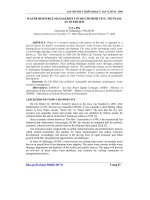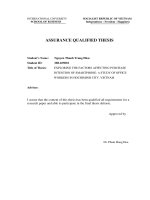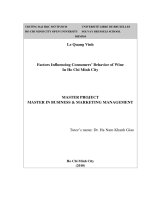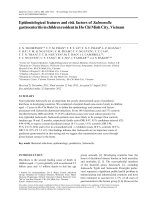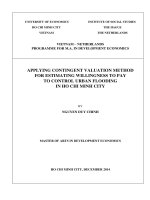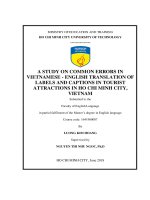Examining factors affecting to employees job satisfaction in international companies in Ho Chi Minh city Vietnam
Bạn đang xem bản rút gọn của tài liệu. Xem và tải ngay bản đầy đủ của tài liệu tại đây (1.89 MB, 61 trang )
TRệễỉNG ẹAẽI HOẽC Mễ TP.HCM UNIVERSITE LIBRE DE BRUXELLES
HO CHI MINH CITY OPEN UNIVERSITY SOLVAY BRUSSELS SCHOOL
MBAVB2
LE QUANG ẹINH
EXAMINING FACTORS AFFECTING TO EMPLOYEES
JOB SATISFACTION IN INTERNATIONAL
COMPANIES IN HO CHI MINH CITY
VIETNAM
MASTER PROJECT
MASTER IN BUSINESS ADMINISTRATION
(PART-TIME)
Tutors Name: Dr. Nguyen Van Ngai
Ho Chi Minh City
(2012)
i
COMMITMENT
I hereby declare that all work in this project was written by myself under the kind
guidance of Dr. Nguyen Van Ngai.
The project “Examining factors affecting to employee’s job satisfaction in international
companies in Ho Chi Minh city, Vietnam” was done in accordance with regulation of
Solvay Business School and Open University of Ho Chi Minh city.
All data and information have been collected by reliable sources, there is no plagiarism
in this study.
Ho Chi Minh City, November 12
th
, 2012
LE QUANG DINH
ii
ACKNOWLEDGEMENT
First of all, I would like to express my deeply gratitude to all professors of the Open
University of Ho Chi Minh City and University Libre De Bruxelles – Solvay Business
School who give me valuable knowledge in business administration.
I would like to express my special thank to Dr. Nguyen Van Ngai, my tutor for his value
guidance and continue support for my study.
I also would like to thank to my classmate in MBAVB2, who usually share valuable
knowledge
Finally, I would like to say a best thank to my parent and my mini family, who are all
the time standing beside me to encourage for the project completing.
Ho Chi Minh City, November 12
th
, 2012
LE QUANG DINH
iii
iv
TABLE OF CONTENTS
Page
Commitment i
Acknowledgment ii
Tutor’s remark iii
Table of contents iv
Abbreviation vi
List of figures vii
List of tables vii
CHAPTER 1: INTRODUCTION 1
1.1 RATIONALE OF STUDY 1
1.2 PROBLEM STATEMENT 1
1.3 STUDY OBJECTIVES 1
1.4 RESEARCH QUESTIONS 2
1.5 HYPOTHESES 2
1.6 SCOPE OF STUDY 3
1.7 RESEARCH METHODOLOGY 3
1.8 STRUCTURE OF THE PROJECT 4
CHAPTER 2: LITERATURE REVIEW 5
2.1 JOB SATISFACTION THEORIES 5
2.1.1
Abraham MaslowTheory(1943) 5
2.1.2 The two-factor theory (Frederick Herzberg,1968) 9
2.1.3 Expectancy theory (Victor H. Vroom, 1964) 12
2.1.4 Equity theory (John Stacey Adams, 1963) ………………………………………………… 13
2.2 JOB SATISFACTION AND BEHAVIORS IN THE WORKPLACE 14
2.2.1 Job satisfaction and job performance 14
2.2.2 Motivation and job satisfaction 15
2.2.3 Organizational commitment and job satisfaction 16
2.2.4 Job satisfaction and absenteeism 16
2.2.5 Job satisfaction and turnover 17
v
2.3 FACTORS AFFECT JOB SATISFACTION 17
2.3.1 Age 17
2.3.2 Gender 18
2.3.3 Year of Service 18
2.3.4 Intrinsic and extrinsic factors 18
2.3.5 Income 19
2.4 STUDIES ON JOB SATISFACTION IN VIETNAM 20
2.5. METHODOLOGY USED IN PAST STUDIES 20
CHAPTER 3: RESEARCH METHODOLOGY 22
3.1 RESEARCH METHODS AND DESIGN 24
3.2 OPERATIONAL DEFINITION OF VARIABLES 25
3.3. INSTRUMENTS 26
3.4. PARTICIPANTS 27
3.5. DATA COLLECTION, PROCESSING, AND ANALYSIS 27
CHAPTER 4: FINDINGS 30
4.1. SAMPLE DESCRIPTIVE STATISTICS 30
4.2. RELIABILITY OF THE INSTRUMENT 31
4.3. TESTING HYPOTHESIS 31
4.3.1. Research question 1 31
4.3.2. Research questions 2 to 5 33
CHAPTER 5: IMPLICATIONS, RECOMMENDATIONS and CONCLUSIONS 45
5.1 IMPLICATIONS 45
5.2 RECOMMENDATIONS 47
5.3 CONCLUSIONS 48
BIBLIOGRAPHY 49
APPENDICES 51
vi
ABBREVIATIONS
ES: Extrinsic
GS: General Satisfaction
HCMC: Ho Chi Minh City
H: Hypothesis
IS: Intrinsic
MSQ-SF:
Minnesota Satisfaction Questionnaire - Short Form
RQ: Research Question
SPSS: Statistical Package for the Social Sciences
vii
LIST OF FIGURES
Figure 1. Histogram of general satisfaction 35
Figure 2. Normal Q-Q plot of general satisfaction 36
Figure 3. Detrended normal Q-Q plot of general satisfaction 36
Figure 4. Scatter plot of general satisfaction 37
Figure 5. Normal P-P plot of regression standardized residual for general satisfaction 40
Figure 6. Scatter plot of regression standardized predicted value for general
satisfaction 41
viii
LIST OF TABLES
Table 1: Operational Variables 23
Table 2: MSQ-SF Scoring Methodology 26
Table 3: Gender 30
Table 4: Cronbach’s Alpha of Job Satisfaction Scores (N = 139) 31
Table 5: Group Statistic 32
Table 6: Independent t test of general satisfaction and gender 32
Table 7: Descriptive Statistics 34
Table 8: Descriptive Statistics of General Satisfaction 34
Table 9: Normality Test of General Satisfaction 35
Table 10: Pearson Correlations 38
Table 11: Collinearity Test of Independent Variables 38
Table 12: Test of Residuals 39
Table 13: Case wise diagnostic 41
Table 14: Model Summary 42
Table 15: Anova table 42
Table 16: Coefficients Table 43
1
CHAPTER 1: INTRODUCTION
1.1 RATIONALE OF STUDY
Job satisfaction plays a pivotal role in human resources management and
success of organizations. Job satisfaction relates to many aspects in organizations. Job
satisfaction is considered to positively relate to job performance and organizational
commitment and negatively impact on absenteeism, intent to leave companies, and
organizational negative behaviors.
1.2 PROBLEM STATEMENT
The problem to be addressed in this study was the low level of job satisfaction of
employees in Vietnam. According a Gallup survey conducted in 2011, Vietnamese
employees are least happy among Asian workers (Yu & Lyons, 2012). Results of the
survey conducted with 1,000 employees in 22 countries in Asia showed that only 48%
of Vietnamese participants were happy with their job, which made Vietnam was at the
bottom of the list of happy employees in Asia (Yu & Lyons, 2012). Many studies of job
satisfaction were conducted with employees at local companies (Dieleman et al., 2003;
Hung et al, 1999; Nguyen, 2008) while rarely international companies were studied on
employee job satisfaction. Understanding the level of job satisfaction of staff and
determining the factors that significantly impact employee job satisfaction may help top
management of international companies find the ways to improve the level of
employee job satisfaction and augment the competitiveness in Vietnam market.
1.3 STUDY OBJECTIVES
The objective of this study were (1) to examine the relationship between demographic
factors (gender, age, year of service) and general job satisfaction of employees at
international companies in Ho Chi Minh City in Vietnam and (2) to determine which
factors (age, year of service, intrinsic, and extrinsic factors) that best predict general job
satisfaction of employees at international companies in Ho Chi Minh City, Vietnam.
2
1.4 RESEARCH QUESTION
In order to examine the relationship between demographic factors (gender, age, year of
service), intrinsic factors, and extrinsic factors and general job satisfaction of
employees at international companies in Ho Chi Minh City, Vietnam, the following
research questions were addressed.
RQ1. Is there a significant difference on general job satisfaction between male and
female employees at international companies in Ho Chi Minh City?
RQ2. To what extent, if any, does age relate to general job satisfaction of employees
at international companies in Ho Chi Minh City?
RQ3. To what extent, if any, does year of service relate to general job satisfaction of
employees at international companies in Ho Chi Minh City?
RQ4. To what extent, if any, do intrinsic factors relate to general job satisfaction of
employees at international companies in Ho Chi Minh City?
RQ5. To what extent, if any, do extrinsic factors relate to general job satisfaction of
employees at international companies in Ho Chi Minh City?
1.5 HYPOTHESES
The null and alternative hypotheses of the study are:
H1
0.
There is no difference on general job satisfaction between male and female
employees at international companies in Ho Chi Minh City.
H1
a
. There is a significant difference on general job satisfaction between male and
female employees at international companies in Ho Chi Minh City.
H2
0
. Age is not significantly correlated to general job satisfaction of employees at
international companies in Ho Chi Minh City.
H2a
.
Age is significantly correlated to general job satisfaction of employees at
international companies in Ho Chi Minh City.
H3
0
. Year of service is not significantly correlated to general job satisfaction of
employees at international companies in Ho Chi Minh City.
3
H3a
.
Year of service is significantly correlated to general job satisfaction of employees
at international companies in Ho Chi Minh City.
H4
0
. Intrinsic factors are not significantly correlated to general job satisfaction of
employees at international companies in Ho Chi Minh City.
H4a
.
Intrinsic factors are significantly correlated to general job satisfaction of
employees at international companies in Ho Chi Minh City.
H5
0
. Extrinsic factors are not significantly correlated to general job satisfaction of
employees at international companies in Ho Chi Minh City.
H5a
.
Extrinsic factors are significantly correlated to general job satisfaction of
employees at international companies in Ho Chi Minh City.
1.6 SCOPE OF STUDY
The population of the study included employees at international companies in Ho Chi
Minh City, Vietnam. Participants of the study included employees who voluntarily
participate in the survey. Participants of the study were managers and staff who work
full-time for the companies.
1.7 RESEARCH METHODOLOGY
The quantitative approach was used in this study to examine the relationship between
gender, age, year of service, intrinsic and extrinsic factors and general job satisfaction
of employees at international companies in Ho Chi Minh City, Vietnam. Independent
variables were gender, age, year of service, intrinsic factors, and extrinsic factors.
Dependent variable is general job satisfaction. Demographic variables (gender, age,
and year of service) were measured by questions created by the researcher. Intrinsic
factors, extrinsic factors, and general job satisfaction were measured by using
Minnesota Satisfaction Questionnaire Short Form (MSQ-SF) created by Weiss, Dawis,
England, and Lofquist (1967). Survey method was used to collect data. SPSS 18.0
software is used to analyze the data. Independent samples t test was used to answer
4
RQ1. Pearson’s correlation tests and multiple regression analyses were used to answer
RQ2, 3, 4, and 5.
1.8 STRUCTURE OF THE PROJECT
Chapter 1: Introduction
The problem statement, objectives of the study are presented in this chapter. Research
questions and associated sets of hypotheses are mentioned. The scope of the study and
methodology are also discussed in this chapter.
Chapter 2: Literature review
In the literature review, job satisfaction and the relationship with other constructs in the
workplace (job performance, organizational commitment, absenteeism, and turnover)
are discussed. Past studies related to factors that affect general job satisfaction are
reviewed in the chapter. Finally, research on job satisfaction conducted in Vietnam is
presented.
Chapter 3: Research methodology
In this chapter, the methodology that is used in the study is discussed thoroughly.
Methods to collect data and analyze data are presented.
Chapter 4: Findings
Results of the data analysis are discussed in this chapter. The results are used to
evaluate the hypotheses and answer the research questions. Comparison the results of
this study and previous studies is discussed at the end of the chapter.
Chapter 5: Recommendations and conclusions
Conclusions of the study are presented in this chapter. Recommendations for practical
application are mentioned.
5
CHAPTER 2: LITERATURE REVIEW
The search for literature and the organization of this chapter was developed
around the key constructs of this study. The literature search and consequently this
chapter include sections related to the areas of job satisfaction and other organizational
constructs. Gaps and inconsistencies in the literature are highlighted in this literature
review, such as the conflicting findings related to whether gender, age, year of service
is related to job satisfaction.
In the first section I will present job satisfaction and the relationship between job
satisfaction and other constructs in the workplace. Next I will continue a discussion of
relationship between job satisfaction and gender, age, year of service, intrinsic and
extrinsic factors. I also mention studies on job satisfaction in Vietnam. Finally, the key
points of the chapter are presented in a summary.
2.1 JOB SATISFACTION THEORIES
Job satisfaction is defined as emotional response by an employee concerning
different aspects of a job. Job satisfaction is also viewed as a systematic phenomenon
where an employee evaluates various attributes of a job
2.1.1
Abraham Maslow Theory (1943)
6
According to Maslow’s hierarchy of needs, human needs motivate action.
People’s needs follow a hierarchy from lower-level needs (e.g., the need for food and
shelter) to higher-level needs (e.g., social needs and self-esteem needs). Employees’
behaviors are affected by the satisfaction of the needs listed in the above hierarchy.
Physiological needs
Physiological needs are the physical requirements for human survival. If these
requirements are not met, the human body cannot function properly, and will ultimately
fail. Physiological needs are thought to be the most important. They should be met first.
They are air, water, and food that need for survival of all animals, including humans.
Safety needs
The needs for safety and security. Security needs are important for survival, but
they are not as demanding as the physiological needs. Examples of security needs
include a desire for a steady employment, health insurance, and shelter from the
environment.
With physical needs relatively to satisfy, the individual's safety needs to
take dominate the behavior. In the absence of physical safety like war, natural disaster,
family violence and in the absence of economic safety such as economic crisis and lack
of work opportunities.
Safety and Security needs include:
Personal security
Financial security
Health and well-being
Safety against accidents/illness
7
Love and belonging
According to Maslow, the need for love and belonging includes the range of
intimacy between people, compassion, sympathy, a sense of having a place in the
world, being part of a community, feeling accepted and approved of rejection and
disapproval, attention, and affection. Situations which would help to satisfy the need for
love and belong will include in the following examples:
Friendship
Engaging in social activities with others
Active participation in classes, clubs, and communities
Working in cooperative and learning groups
Working cooperatively with others on a project
Intimacy
Family
Physical or emotional of a child by a parent
After physiological and safety needs are fulfilled, the third level of human needs is
interpersonal and involves feelings of the belongingness. This need is especially strong
in childhood and can override the need for safety as children who needs take care from
parents.
Humans need to love and be loved. Many people become sensitive to loneliness,
social anxiety, and depression in the absence of the love or belonging elements. This
need for belonging may overcome the physiological and security needs.
Esteem
All humans have a need to feel respected. This includes the need to have self-
esteem and self-respect. Esteem presents for the human’s desire to be accepted and
valued by others. People often engage in a profession way to be recognition. These
activities give the person a sense of contribution or value. Low self-esteem may result
8
from imbalances during this level in the hierarchy. People with low self-esteem often
need respect from others.
Most people have a need for a stable self-respect and self-esteem. From
Maslow, there are two versions of esteem needs: a 'lower' and a 'higher' version. The
'lower' version of esteem is the need for respect from others. This may include a need
for status, recognition, famous, prestige, and attention. The 'higher' version is the need
for self-respect. For example, the person may have a need for strength, competence,
mastery, self-confidence, independence, and freedom. This 'higher' version takes
priority on the 'lower' version because it relies on an inner competence established
through experience.
Self-actualization
This level of need refers to what a person's full potential is and the realization of
that potential. Maslow describes this level as the desire to accomplish everything that
people can do to become the most that they can be. For example, a person may have a
strong desire to become a billionaire, the other person may be expressed to be president
of country.
From the theory, the lower-level of job satisfaction is easier to satisfy than
higher-level because the need of lower-level is in limit resources and able to affected
by extrinsic factors. In initial time lower-level is operating, it requests for job
satisfaction to employee, thus this is motivate factor. It will be not a motivational factor
anymore if the need is satisfied then higher-level of job satisfaction will appear.
Maslow’s hierarchy is very important to managers or leaders of company or
organization. The managers or leaders want to motivate employee to working
productivity, they should understand where is employee was in levels of hierarchy.
Well understanding help managers or leaders making a suitable decision or solution to
job satisfaction of employee (Nguyen Huu Lam, 1996, page 119-121)
9
Therefore, managers or leaders need to study and research for understand to
offer the right needs of employee in order to have corresponding solutions in Human
resource management. For example: A freshman who has just recruited for company or
organization, the most important things is giving a job and basic salary that is first
priority in the circumstance. In contradiction, an experience employee needs for
promotion which is most important.
2.1.2 The two-factor theory (Frederick Herzberg, 1968)
The two-factor theory of job satisfaction was developed and the focus of the
theory was that different factors caused job satisfaction and job dissatisfaction
(Herzberg, 1968). Motivators (i.e., achievement, promotion, and recognition) can lead
to job satisfaction. Dissatisfied with hygiene factors (i.e., pay, working conditions, and
company policies) may cause job dissatisfaction. Thus, job satisfaction and job
dissatisfaction were viewed as two different factors rather than opposite each other.
According to the two factor theory of F. Herzberg, peoples are influenced by
two factors. Satisfaction and psychological growth was a factor of motivation.
Dissatisfaction was a result of hygiene factor.
Hygiene factors are needed to ensure an employee does not become dissatisfy.
They do not lead to higher levels of motivation, but without them there is
10
dissatisfaction. Hygiene factors are those job factors which are essential for existence
of motivation at workplace. These factors do not lead to positive satisfaction for long-
term. But if these factors are absent at workplace, then they lead to dissatisfaction.
In other words, hygiene factors are those factors which reasonable in a job, and
do not make employee come to dissatisfy. These factors are extrinsic to work. Hygiene
factors are required to avoid dissatisfaction. These factors describe the job
environment. The hygiene factors symbolized the physiological needs which the
individuals wanted and expected to be fulfilled.
Motivation factors are needed in order to motivate an employee into a higher
performance. These factors come from internal generation of employee.
According to Herzberg, the motivational factors address to positive job satisfaction.
These factors belong to work and motivate the employees for a higher performance.
The are involved in performance of the job. Employees find these factors intrinsically
rewarding. The motivators symbolized the psychological needs that were perceived as
an additional benefit
Typical of Hygiene factors:
Working condition: The working conditions should be safe, clean and hygienic.
The work equipments should be updated and well-maintained.
Quality of supervision
Salary: salary structure should be appropriate and reasonable. It must be equal
and competitive to those in the same industry.
Fringe benefits: The employees should be offered health care plans (medical
claim), benefits for the family members, private car for employee. This is added
value/benefit for employee beside salary.
Status: The employees’ status within the organization should be familiar and
retained.
Job Security: The organization must provide job security to the employees
11
Company policies and administration: The company policies should not be too
rigid. They should be fair and clear. It should include flexible working hours,
vacation.
Interpersonal relation: The relationship of the employees with his peers,
superiors and subordinates should be appropriate and acceptable. There should
be no conflict.
Typical of motivation factors:
Achievement: The employees must have a sense of achievement. This depends
on the job.
Recognition: The employees should be praised and recognized for their
accomplishments by the managers or leaders.
Responsibility for tasks: The employees must responsible for the work. The
managers or leaders should give them ownership of the work. They should
minimize control but retain accountability.
Interest in job: The work itself should be meaningful, interesting and
challenging for the employee to perform and to get motivation.
Growth and promotional opportunities: There must be growth and advancement
opportunities in an organization to motivate the employees to perform well.
Limitations of Two-Factor Theory
The two factor theory is not free from limitations:
The two-factor theory overlooks situational variables.
Herzberg assumed that a correlation between satisfaction and productivity. But
the research conducted by Herzberg stressed upon satisfaction and ignored
productivity.
No comprehensive measure of satisfaction was used. An employee may find his
job acceptable despite the fact that he may hate his job.
12
The two factor theory is not free from bias as it is based on the natural reaction
of employees when they are enquired the sources of job satisfaction and
dissatisfaction at work. They will blame dissatisfaction on the external factors
such as salary structure, company policies and peer relationship. Also, the
employees will give credit to themselves for the satisfaction factor at workplace.
Implications of Two-Factor Theory
The Two-Factor theory implies that the managers or leaders must stress on
guaranteeing the suitable of the hygiene factors to avoid employee dissatisfaction.
Also, they must make sure that the work is stimulating and rewarding so that the
employees are motivated to work and perform harder and better. This theory
emphasize on job-enrichment to motivate the employees. The job must utilize the
employee’s skills and competencies to the maximum effort. Focusing on the
motivational factors can improve work-quality.
2.1.3 Expectancy theory (Victor H. Vroom, 1964)
Expectancy theory proposes that a person will decide to behave or act in a
certain way because they are motivated to select a specific behavior over other
behaviors due to what they expect the result of that selected behavior will be. The
motivation of the behavior selection is determined by the desirability of the outcome.
However, at the core of the theory is the cognitive process of how an individual
13
processes the different motivational elements. This is done before making the ultimate
choice. The outcome is not the sole determining factor in making the decision of how to
behave.
Victor H. Vroom (1964) defines motivation as a process governing choices
among alternative forms of voluntary activities, a process controlled by the individual.
The individual makes choices based on estimates of how well the expected results of a
given behavior are going to match up with or eventually lead to the desired results.
Motivation is a product of the individual’s expectancy that a certain effort will lead to
the intended performance, the instrumentality of this performance to achieving a
certain result, and the desirability of this result for the individual, known as valence
Therefore, to motivating employee manager or leader needs to pay high
intention to employee’s awareness and expectation which address to situation, reward,
easy way for themselves to take reward and make sure the reward is correctly sent to
employee. Expectancy theory requests managers or leaders must understand
employee’s expectation together with company or organization goal. Manager or
leaders should create the essential work to achieve company or organization’ goal,
ensure the goal can be reached, evaluate real situation forward to different expectation
in order to make sure the reward is attractive to employee and fair to all (Nguyen Huu
Lam, 1996, page 127-128).
2.1.4 Equity theory
(John Stacey Adams, 1963)
Equity theory is a motivational theory which was developed by John Stacey
Adams in 1963, a workplace and behavioral psychologist, who asserted that employees
seek to maintain equity between the inputs that they bring to a job and the outcomes
that they receive from it against the perceived inputs and outcomes of others.
According to theory, generating a strong equality will help to reinforce
relationship with employee to motivate and enhance their job satisfaction. It will make
a highly productivity of employee and stabilize turnover in company. Whereas,
employee will lose their working interesting and enthusiasm in work if they do feeling
14
contribute more but less reward. Some examples of dissatisfaction: decrease
enthusiasm which depend on their perceive on equality, none effort, easy to be
angered, or even intend to leave company or organization. Thus, equity theory is very
useful for manager or leader to enhance employee job satisfaction.
The equity theory request to manager or leaders must consider to factors affect
on employee’s awareness to equality and act to help employee has their own awareness
about equality (Nguyen Huu Lam, 1996, page 129-130)
In the next section the relationship between job satisfaction and other
organizational constructs are discussed. The constructs include job performance,
motivation, customer satisfaction, tardiness, absenteeism, and turnover. Literature on
factors relating to job satisfaction is presented next.
2.2 JOB SATISFACTION AND BEHAVIORS IN THE WORKPLACE
In the past, thousands of studies have examined the relationship between job
satisfaction and other important organizational variables. For example, studies showed
that satisfied workers are more productive and perform better (Souza-Poza & Souza-
Poza, 2000). The research has further demonstrated that low job satisfaction can lead to
higher absenteeism and turnover. Rogers et al. (1994) have further demonstrated that
there is a relationship in service industries between employee and customer
satisfaction. Additionally, many studies showed the link between job satisfaction and
worker health. Finally, job satisfaction is an important predictor of overall well-being.
2.2.1 Job satisfaction and job performance
The first attempts to study the impact of job satisfaction on job performance
occurred in the 1930s via the Hawthorne studies. Since then, the relationship between
the two constructs had become one of the greatest topics within research on
organizational behavior. Many studies were conducted to explain the link between job
satisfaction and job performance . The unclear relationship between the two variables
15
was showed in some studies, whereas other studies supported the significant job
satisfaction-job performance association (Petty, McGee, & Cavender, 1984).
Recent studies supported the significant correlation between job satisfaction and
job performance. Results of a study with sales people in North America supported the
positive influence of job satisfaction on job performance (Mulki, Jaramillo, &
Locander, 2009. Job satisfaction has a positive impact on job performance since highly
satisfied employees usually perform better than employees with lower levels of job
satisfaction. Job satisfaction results into high attitude and morale towards work, which
subsequently impacts positively on the overall employee’s performance.
The relationship between job satisfaction and job performance is also proved via
the job satisfaction-customer satisfaction link. Customer satisfaction is associated with
satisfied employees, which raises the importance of employee satisfaction especially
among workers who interact with clients (Swapna & Prabhakar, 2011). In addition,
employees with higher levels of job satisfaction have lesser tendencies for being absent
(Whitman et al., 2010). Working with satisfied staff allows customers to become
familiar with the staff and ensures the services received are from qualified employees.
As a result, customers express satisfaction and loyalty toward the goods and services
provided by the organization. Highly satisfied workers would always try to work better
for the organization, leading to higher satisfaction among the organizations’ customers.
On this basis, job satisfaction and customer satisfaction are positively related in the way
they complement each other. In the currently competitive business environment,
organizational managers should pursue customer satisfaction by enhancing employee
job satisfaction.
2.2.2 Motivation and job satisfaction
The two constructs motivation and job satisfaction were described in the work of
Frederick Herzberg. The intrinsic factors are called motivators that affect the level of
employee job satisfaction (Herzberg, 1968). Research on the correlation between job
satisfaction and motivation was continued in some famous theories such as Expectancy
theory (Victor H. Vroom, 1964) and Equity theory (Adams, 1963). The job satisfaction-
16
motivation link is demonstrated in many studies in the 21st century. A significantly
direct correlation between job satisfaction and motivation was proved from the findings
from a meta-analysis involving 1,739 employees in nine studies. Similarly, there is a
significant correlation between satisfaction with supervision and motivation, which
prompts managers to evaluate leadership behaviors based on the impact on employee
satisfaction (Kinicki & Kreitner, 2008). Findings from a study with military staff in
Canada showed a high positive relationship between job satisfaction and motivation in
work place (Tremblay et al., 2009). Results from another study with retail store
employees in Australia supported the positive correlation between job satisfaction and
motivation (Kantabura & Avery, 2007). Thus, managers or leaders have the opportunity
to improve the employees’ motivation toward work by exerting efforts toward
increasing job satisfaction. The more motivation that the more satisfaction to employee.
2.2.3 Organizational commitment and job satisfaction
A moderate and significant relationship between the two constructs
(organizational commitment and job satisfaction) was proved from the findings from a
meta-analytical study conducted on 879 studies involving 490,624 respondents (Cooper-
Hakim & Viswesvaran, 2005). Organizational commitment was proved to correlate
significantly with employee satisfaction from a study in Thailand (Ogunlana, 2008).
Leaders are instructed to work on increasing job satisfaction to solicit higher
organizational commitment (Cooper- Hakim & Viswesvaran, 2005; Malik et al., 2010).
High employee satisfaction leads to high organizational commitment and the link
between these two constructs plays a pivotal role in the success of organizations.
2.2.4 Job satisfaction and absenteeism
Findings from studies conducted recently proved the significant relationship
between these two constructs . The significant negative correlation between
absenteeism and job satisfaction was proved in a meta-analysis of 60 studies (Whitman
et al., 2010).
